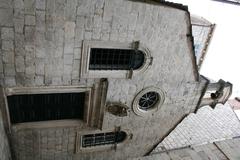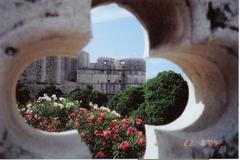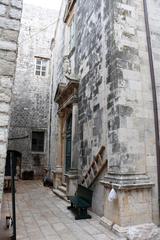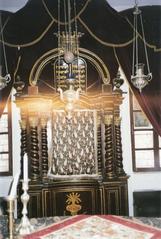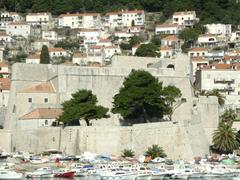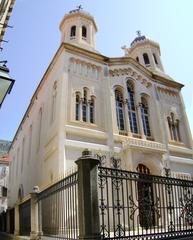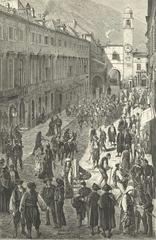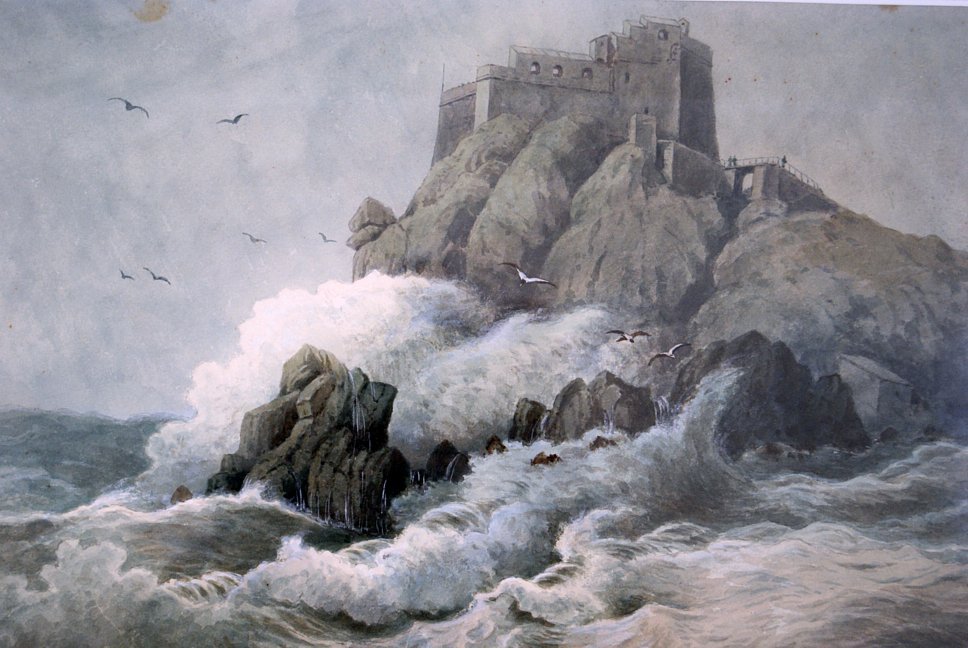
Visiting Lovrijenac Fortress: History, Tips, and Visitor Information
Date: 18/07/2024
Introduction
Perched majestically atop a 37-meter-high sheer rock just outside Dubrovnik’s western wall, Fort Lovrijenac, also known as Fort Lawrence, is an iconic symbol of the city’s resilience and rich historical tapestry. Often likened to Dubrovnik’s Gibraltar, Lovrijenac has served as a formidable guardian against numerous invasions, most notably thwarting Venetian aspirations in the 11th century. The fortress’s strategic location, with commanding views over both the Pile Gate and the harbor at Gruž, has cemented its importance in the annals of maritime defense (Dubrovnik Card).
Lovrijenac’s origins are steeped in legend, with tales of an initial wooden fortification dating as far back as the 9th century. The first documented evidence, however, points to 1018 as the beginning of its transformation into the stone bastion we recognize today (Dubrovnik Summer Festival). Over the centuries, Lovrijenac has evolved architecturally to meet the technological advancements of warfare and embraced a broader cultural role. Since 1936, it has been a venue for the Dubrovnik Summer Festival, hosting open-air performances of Shakespeare’s plays, including the renowned ‘Hamlet’ (Dubrovnik Card).
This comprehensive guide aims to take you on a journey through Lovrijenac’s captivating history, provide essential visitor information, and highlight its cultural significance, ensuring that your visit is both informative and memorable.
Table of Contents
- [A Bastion of Defense - Lovrijenac’s Storied Past](#a-bastion-of-defense---lovrijenacs-storied-pasta-bastion-of-defense---lovrijenacs-storied-past)
- [Legends and Early Beginnings](#legends-and-early-beginningslegends-and-early-beginnings)
- [The Rise of a Stone Guardian (11th Century Onwards)](#the-rise-of-a-stone-guardian-11th-century-onwardsthe-rise-of-a-stone-guardian-11th-century-onwards)
- [A Symbol of Defiance - Thwarting the Venetian Threat](#a-symbol-of-defiance---thwarting-the-venetian-threata-symbol-of-defiance---thwarting-the-venetian-threat)
- [Strengthening the Defenses - Architectural Evolution (14th - 16th Centuries)](#strengthening-the-defenses---architectural-evolution-14th---16th-centuriesstrengthening-the-defenses---architectural-evolution-14th---16th-centuries)
- [Cultural Significance](#cultural-significancecultural-significance)
- [Visitor Information](#visitor-informationvisitor-information)
- [Ticket Prices and Visiting Hours](#ticket-prices-and-visiting-hoursticket-prices-and-visiting-hours)
- [Travel Tips and Accessibility](#travel-tips-and-accessibilitytravel-tips-and-accessibility)
- [Nearby Attractions](#nearby-attractionsnearby-attractions)
- [Conclusion](#conclusionconclusion)
- [FAQ](#faqfaq)
- [References](#referencesreferences)
Legends and Early Beginnings
While the exact origins of Lovrijenac remain shrouded in some mystery, legends abound, painting a vivid picture of its early significance. One such legend claims that a formidable fortress, constructed of wood, once occupied the site as early as the 9th century. This early structure supposedly served as a crucial defense against both Venetian and Narentine aspirations to seize control of this strategically vital location.
The Rise of a Stone Guardian (11th Century Onwards)
The first documented evidence of Lovrijenac dates back to 1018, marking the beginning of its transformation into the imposing stone fortress we see today. The construction of the fort, however, was a gradual process, evolving and adapting over centuries to meet the ever-changing demands of defense.
The early 11th century saw the Venetians, with their ever-expanding maritime empire, posing a significant threat to Dubrovnik’s independence. Recognizing the imminent danger, the resourceful people of Dubrovnik embarked on an ambitious project—the construction of a formidable fortress that would safeguard their city from maritime attacks. Lovrijenac, with its commanding position overlooking the sea, was the perfect location for this endeavor.
A Symbol of Defiance - Thwarting the Venetian Threat
The strategic brilliance of Lovrijenac’s location cannot be overstated. Perched high above the sea, its cannons boasted a commanding range, effectively controlling access to both the Pile Gate, the western entrance to the city, and the harbor at Gruž. This strategic advantage was never more apparent than in 1038 when, according to historical accounts, Lovrijenac played a pivotal role in repelling a Venetian siege. The fortress, still under construction at the time, effectively thwarted the Venetian fleet, forcing them to abandon their plans of conquest.
Strengthening the Defenses - Architectural Evolution (14th - 16th Centuries)
The following centuries witnessed a period of significant expansion and fortification for Lovrijenac. The threat posed by the Venetians remained a constant, prompting the people of Dubrovnik to continually reinforce their defenses. During the 14th and 15th centuries, the fortress underwent extensive renovations and expansions, its walls thickened and reinforced to withstand the increasingly powerful artillery of the time.
The 16th century ushered in a new era of warfare, with the advent of gunpowder and cannons. Lovrijenac, once again, adapted to meet these challenges. The fortress was further fortified, its design modified to accommodate powerful cannons, transforming it into a formidable bastion capable of withstanding even the most determined attacks. This period saw the addition of triangular buttresses on the fort’s seaward side, a testament to the ingenuity of Dubrovnik’s engineers in bolstering its defenses against the burgeoning threat of cannon fire.
Cultural Significance
Lovrijenac’s significance extends beyond its military history. Over the centuries, the fortress has served various purposes, reflecting the changing needs of the city it protected. It has housed a prison, a military garrison, and even a storage facility for gunpowder and ammunition.
Beyond its practical uses, Lovrijenac has also been a place of cultural significance. Its dramatic setting, perched atop a rugged cliff overlooking the Adriatic, has made it a popular venue for theatrical performances. Since 1936, the fortress has been home to the Dubrovnik Summer Festival, hosting open-air performances of Shakespeare’s Hamlet, among other renowned plays. This tradition continues to this day, drawing visitors from around the world to experience the magic of theater against the backdrop of this historic fortress.
Visitor Information
Ticket Prices and Visiting Hours
Visitors can explore Lovrijenac’s various levels, marvel at the ingenuity of its design, and imagine the lives of the soldiers who once manned its walls. The visiting hours are usually from 8:00 AM to 7:00 PM, but it is advisable to check the official website or local tourist information for any changes. Ticket prices vary, with discounts available for students and groups.
Travel Tips and Accessibility
The fortress is accessible by foot from Dubrovnik’s Old Town, with a moderate climb up the steps leading to its entrance. Comfortable footwear is recommended due to the uneven terrain. There are no elevators, so visitors with mobility issues may find it challenging to explore all areas of the fortress.
Nearby Attractions
While visiting Lovrijenac, you can also explore other nearby attractions such as the Dubrovnik City Walls, the Pile Gate, and the historic Old Town. These sites provide a comprehensive look at Dubrovnik’s rich history and cultural heritage.
Conclusion
Today, Lovrijenac stands as a proud symbol of Dubrovnik’s enduring spirit and its unwavering commitment to freedom and independence. No longer a military stronghold, the fortress has been meticulously preserved, its imposing walls and ramparts offering a glimpse into a turbulent past. Visitors can explore its various levels, marvel at the ingenuity of its design, and imagine the lives of the soldiers who once manned its walls.
Standing atop Lovrijenac, gazing out at the azure waters of the Adriatic, one can’t help but feel a sense of awe and respect for the history etched into its very stones. It is a reminder of the indomitable spirit of Dubrovnik, a city that, against all odds, preserved its independence for centuries, its legacy forever intertwined with the fortress that stands guard at its gates.
FAQ
Q: What are the visiting hours for Lovrijenac?
A: The visiting hours are usually from 8:00 AM to 7:00 PM, but it is advisable to check the official website or local tourist information for any changes.
Q: How much are tickets to Lovrijenac?
A: Ticket prices vary, with discounts available for students and groups. It’s best to check the latest prices on the official website.
Q: Is Lovrijenac accessible for people with mobility issues?
A: The fortress has uneven terrain and no elevators, so visitors with mobility issues may find it challenging to explore all areas.
Q: What other attractions are near Lovrijenac?
A: Nearby attractions include the Dubrovnik City Walls, the Pile Gate, and the historic Old Town.
References
- Exploring Lovrijenac: History, Visiting Hours, and Cultural Significance in Dubrovnik, 2024, Dubrovnik Card
- Exploring Lovrijenac Fortress: Visiting Hours, Tickets, and Must-See Attractions in Dubrovnik, 2024, Dubrovnik Summer Festival
- Planning Your Visit to Lovrijenac Fortress: Tickets, Tips, and Must-See Attractions in Dubrovnik, 2024, Dubrovnik Card

